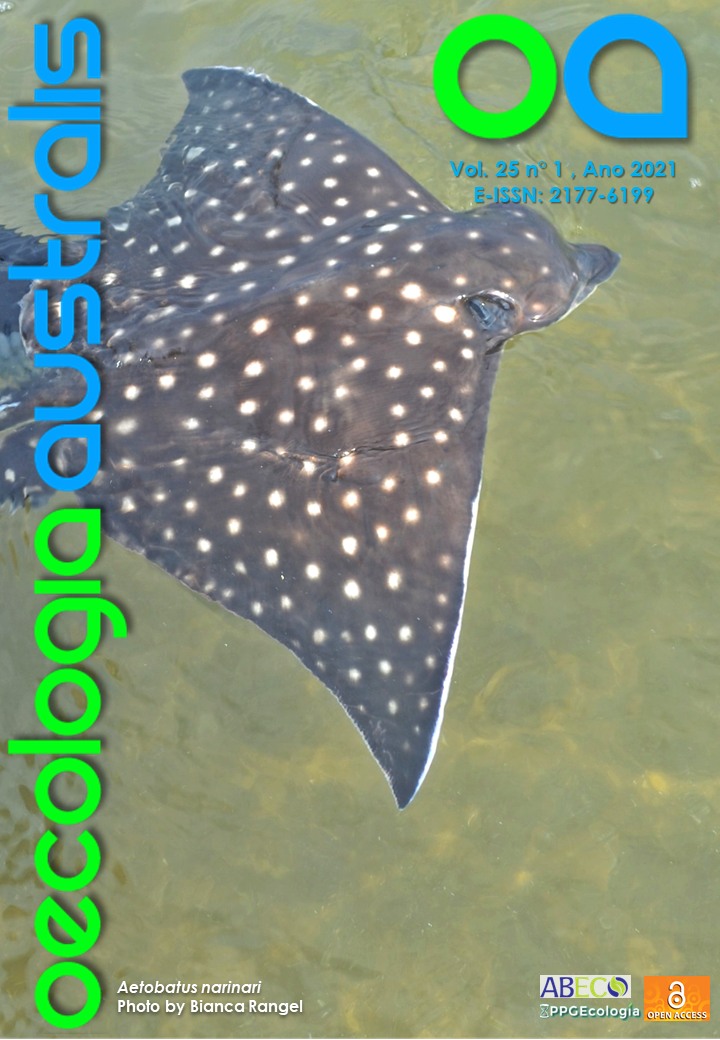CAPTURE AND HANDLING STRESS IN INCIDENTALLY CAPTURED RAYS FROM SMALL-SCALE FISHING: A PHYSIOLOGICAL APPROACH
DOI:
https://doi.org/10.4257/oeco.2021.2501.20Keywords:
Incidental capture, elasmobranchs, non-lethal research, beach seine fishing, batoid, stingrays.Abstract
Incidental capture is the most common threat to rays worldwide, by both artisanal and industrial fishing. To better understand this threat, we evaluated the capture and handling stress in three incidentally captured benthopelagic ray species: American cownose ray (Rhinoptera bonasus), Brazilian cownose ray (Rhinoptera brasiliensis), spotted eagle ray (Aetobatus narinari), and one benthic species, the longnose stingray (Hypanus guttatus). Through analyzing secondary stress physiological variables (plasma lactate and glucose), our results revealed a similar physiological stress response in benthopelagic rays, suggesting they are resilient to capture using beach seine fishing. We also demonstrated that handling for research can increase the stress in both American cownose and spotted eagle rays, suggesting that more stringent handling protocols for research should be required. Findings from this study expands on the number of ray species for which stress to capture and handling has been evaluated, providing recommendations for appropriate research and management.
Downloads
References
Adnet, S., Cappetta, H., Guinot, G. & Notarbartolo Di Sciara, G. 2012. Evolutionary history of the devilrays (Chondrichthyes: Myliobatiformes) from fossil and morphological inference. Zoological Journal of the Linnean Society, 166 (1), 132–159. DOI: 10.1111/j.1096-3642.2012.00844.x
Ajemian, M. J., & Powers, S. P. 2014. Towed-float satellite telemetry tracks large-scale movement and habitat connectivity of myliobatid stingrays. Environmental Biology of Fishes, 97 (9), 1067–1081. DOI: 10.1007/s10641-014-0296-x
Bouyoucos, I. A., Simpfendorfer, C. A., & Rummer, J. L. 2019. Estimating oxygen uptake rates to understand stress in sharks and rays. Reviews in Fish Biology and Fisheries, 29(2), 297–311. DOI: 10.1007/s11160-019-09553-3
Cain, D. K., Harms, C. A., & Segars, A. 2004. Plasma biochemistry reference values of wild-caught southern stingrays (Dasyatis americana). Journal of Zoo Animal Medicine, 35 (4), 471–477. DOI: 10.1638/03-107
Cicia, A. M., Schlenker, L. S., Sulikowski, J. A. & Mandelman, J. W. 2012. Seasonal variations in the physiological stress response to discrete bouts of aerial exposure in the little skate, Leucoraja erinacea. Comparative Biochemistry and Physiology Part A: Molecular & Integrative Physiology, 162 (2), 130–138. DOI: 10.1016/j.cbpa.2011.06.003
Dulvy, N. K., Simpfendorfer, C. A., Davidson, L. N., Fordham, S. V., Bräutigam, A., Sant, G., & Welch, D. J. 2017. Challenges and priorities in shark and ray conservation. Current Biology, 27 (11), R565–R572. DOI: 10.1016/j.cub.2017.04.038
Gallagher, A. J., Serafy, J. E., Cooke, S. J., & Hammerschlag, N. 2014. Physiological stress response, reflex impairment, and survival of five sympatric shark species following experimental capture and release. Marine and Ecology Progress Series, 496, 207–218. DOI: 10.3354/meps10490
Gallagher, A. J., Staaterman, E. R., Cooke, S. J., & Hammerschlag, N. 2016. Behavioural responses to fisheries capture among sharks caught using experimental fishery gear. Canadian Journal of Fishes and Aquatic Science, 74 (1), 1–7. DOI: 10.1139/cjfas-2016-0165
Hoffmayer, E. R., Hendon, J. M. & Parsons, G. R. 2012. Seasonal modulation in the secondary stress response of a carcharhinid shark, Rhizoprionodon terraenovae. Comparative Biochemistry and Physiology Part A: Molecular & Integrative Physiology, 162 (2), 81–87. DOI: 10.1016/j.cbpa.2011.05.002
Jerome, J. M., Gallagher, A. J., Cooke, S. J., & Hammerschlag, N. 2017. Integrating reflexes with physiological measures to evaluate coastal shark stress response to capture. ICES Journal of Marine Sciences, 75 (2), 796–804. DOI: 10.1093/icesjms/fsx191
Lambert, F. N., Treberg, J. R., Anderson, W. G., Brandt, C., & Evans, A. N. 2018. The physiological stress response of the Atlantic stingray (Hypanus sabinus) to aerial exposure. Comparative Biochemistry and Physiology Part A: Molecular & Integrative Physiology, 219, 38–43. DOI: 10.1016/j.cbpa.2018.02.009
Last, P. R., Naylor, G. J., & Manjaji-Matsumoto, B. M. 2016. A revised classification of the family Dasyatidae (Chondrichthyes: Myliobatiformes) based on new morphological and molecular insights. Zootaxa, 4139 (3), 345–368. DOI: 10.11646/zootaxa.4139.3.2
Marshall, H., Field, L., Afiadata, A., Sepulveda, C., Skomal, G., & Bernal, D. 2012. Hematological indicators of stress in longline-captured sharks. Comparative Biochemistry and Physiology Part A: Molecular & Integrative Physiology, 162(2), 121–129. DOI: 10.1016/j.cbpa.2012.02.008
Moyes, C. D., Fragoso, N., Musyl, M. K., & Brill, R. W. 2006. Predicting post-release survival in large pelagic fish. T. Am. Fish. Soc. 135 (5), 1389–1397. DOI: 10.1577/T05-224.1
Prohaska, B. K., Bethea, D. M., Poulakis, G. R., Scharer, R. M., Knotek, R., Carlson, J. K., & Grubbs, R. D. 2018. Physiological stress in the smalltooth sawfish: effects of ontogeny, capture method, and habitat quality. Endangered Species Research, 36, 121–135. DOI: 10.3354/esr00892
Rangel, B. S., Rodrigues, A., & Moreira, R. G. 2018. Use of a nursery area by cownose rays (Rhinopteridae) in southeastern Brazil. Neotropical Ichthyology, 16, e170089. DOI: 10.1590/1982-0224-20170089.
Ruiz-Jarabo, I., Barragán-Méndez, C., Jerez-Cepa, I., Fernández-Castro, M., Sobrino, I., Mancera, J. M., & Aerts, J. 2019. Plasma 1α-hydroxycorticosterone as biomarker for acute stress in catsharks (Scyliorhinus canicula). Frontiers in Physiology, 10, 1217. DOI: 10.3389/fphys.2019.01217
Skomal, G. B., & Mandelman, J. W. 2012. The physiological response to anthropogenic stressors in marine elasmobranch fishes: a review with a focus on the secondary response. Comparative Biochemistry and Physiology Part A: Molecular & Integrative Physiology, 162 (2), 146–155. DOI: 10.1016/j.cbpa.2011.10.002
Stevens, J. D., Bonfil, R., Dulvy, N. K. & Walker, P. A. 2000. The effects of fishing on sharks, rays, and chimaeras (chondrichthyans), and the implications for marine ecosystems. ICES Journal of Marine Science, 57 (3), 476–494. DOI: 10.1006/jmsc.2000.0724
Wheeler, C. R., Gervais, C. R., Johnson, M. S., Vance, S., Rosa, R., Mandelman, J. W., & Rummer, J. L. 2020. Anthropogenic stressors influence reproduction and development in elasmobranch fishes. Reviews in Fish Biology and Fisheries, 30, 373–386. DOI: 10.1007/s11160-020-09604-0
Wilson, S. M., Raby, G. D., Burnett, N. J., Hinch, S. G., & Cooke, S. J. 2014. Looking beyond the mortality of bycatch: sublethal effects of incidental capture on marine animals. Biological Conservation, 171, 61–72. DOI: 10.1016/j.biocon.2014.01.020
Wosnick, N., Awruch, C. A., Adams, K. R., Gutierre, S. M. M., Bornatowski, H., Prado, A. C., & Freire, C. A. 2019. Impacts of fisheries on elasmobranch reproduction: high rates of abortion and subsequent maternal mortality in the shortnose guitarfish. Animal Conservation, 22(2), 198–206. DOI: 10.1111/acv.12458


